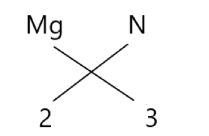
Explain the formation of
Answer
470.7k+ views
Hint:A chemical bond is formed between two atoms of different or same elements by either sharing of electrons (covalent bond), or between two atoms having a large difference in their electron affinity (ionic bonding).
Complete step by step solution:
Now to identify the formation of in
Magnesium is a group 2 element, and the valence of the element is +2.
This gives us the valence of the 3 Mg atom as +6.
And the valence of one nitrogen atom is -3, which implies the valence of 2 nitrogen atom is -6
We can see that
The molecular formula of

Hence, the formation of
Additional information:Steps to use in determining the molecular formula of diatomic molecules using criss cross valence,
i. Identify the valence of each atom using the knowledge of periodic table
ii. Exchange the valence of the atoms with each other
iii. Reduce the valence number to the lowest ratio, if possible
iv. Write the chemical formula.
Let’s assume that we have 2 atoms X and Y, having valence 2 and 4 respectively, using criss cross valence we can write the molecular formula as
Note:The numbers written under magnesium and nitrogen (i.e., 3 and 2 respectively) represents the number of atoms of magnesium and nitrogen present in one
Complete step by step solution:
Now to identify the formation of in
Magnesium is a group 2 element, and the valence of the element is +2.
This gives us the valence of the 3 Mg atom as +6.
And the valence of one nitrogen atom is -3, which implies the valence of 2 nitrogen atom is -6
We can see that
The molecular formula of

Hence, the formation of
Additional information:Steps to use in determining the molecular formula of diatomic molecules using criss cross valence,
i. Identify the valence of each atom using the knowledge of periodic table
ii. Exchange the valence of the atoms with each other
iii. Reduce the valence number to the lowest ratio, if possible
iv. Write the chemical formula.
Let’s assume that we have 2 atoms X and Y, having valence 2 and 4 respectively, using criss cross valence we can write the molecular formula as
Note:The numbers written under magnesium and nitrogen (i.e., 3 and 2 respectively) represents the number of atoms of magnesium and nitrogen present in one
Recently Updated Pages
Master Class 11 Economics: Engaging Questions & Answers for Success

Master Class 11 Business Studies: Engaging Questions & Answers for Success

Master Class 11 Accountancy: Engaging Questions & Answers for Success

Master Class 11 English: Engaging Questions & Answers for Success

Master Class 11 Computer Science: Engaging Questions & Answers for Success

Master Class 11 Maths: Engaging Questions & Answers for Success

Trending doubts
State and prove Bernoullis theorem class 11 physics CBSE

What are Quantum numbers Explain the quantum number class 11 chemistry CBSE

Write the differences between monocot plants and dicot class 11 biology CBSE

Why is steel more elastic than rubber class 11 physics CBSE

Explain why a There is no atmosphere on the moon b class 11 physics CBSE

1 ton equals to A 100 kg B 1000 kg C 10 kg D 10000 class 11 physics CBSE




